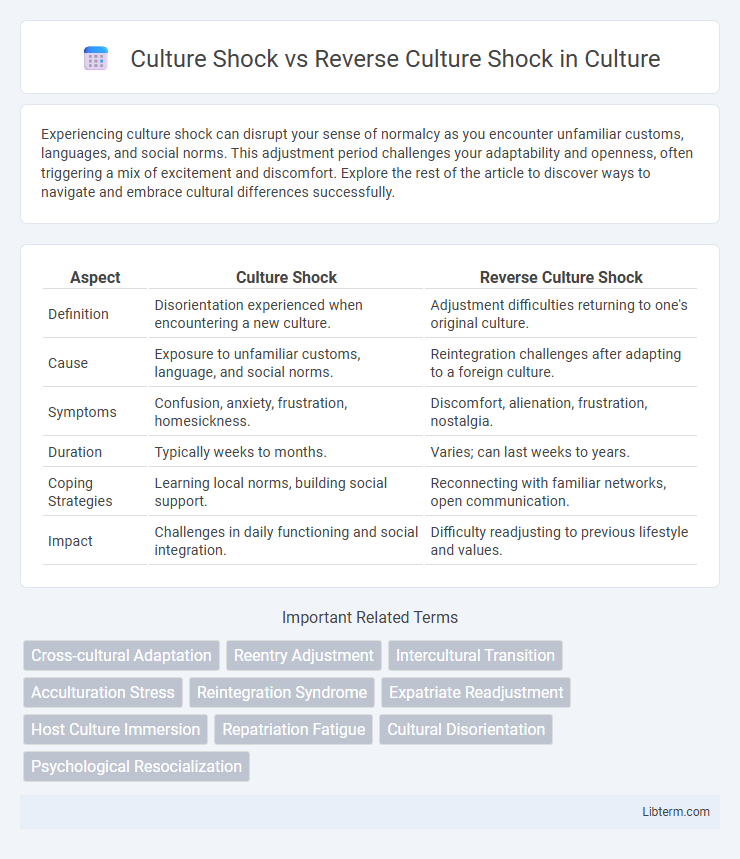Experiencing culture shock can disrupt your sense of normalcy as you encounter unfamiliar customs, languages, and social norms. This adjustment period challenges your adaptability and openness, often triggering a mix of excitement and discomfort. Explore the rest of the article to discover ways to navigate and embrace cultural differences successfully.
Table of Comparison
| Aspect | Culture Shock | Reverse Culture Shock |
|---|---|---|
| Definition | Disorientation experienced when encountering a new culture. | Adjustment difficulties returning to one's original culture. |
| Cause | Exposure to unfamiliar customs, language, and social norms. | Reintegration challenges after adapting to a foreign culture. |
| Symptoms | Confusion, anxiety, frustration, homesickness. | Discomfort, alienation, frustration, nostalgia. |
| Duration | Typically weeks to months. | Varies; can last weeks to years. |
| Coping Strategies | Learning local norms, building social support. | Reconnecting with familiar networks, open communication. |
| Impact | Challenges in daily functioning and social integration. | Difficulty readjusting to previous lifestyle and values. |
Understanding Culture Shock
Culture shock occurs when individuals face disorientation and stress adapting to a new cultural environment, characterized by challenges such as language barriers, differing social norms, and unfamiliar customs. This psychological adjustment process involves stages like honeymoon, frustration, adjustment, and acceptance, impacting emotional well-being and daily functioning. Understanding culture shock enables better coping strategies and smoother integration into the host culture, reducing anxiety and promoting cultural sensitivity.
What is Reverse Culture Shock?
Reverse culture shock occurs when individuals return to their home country after an extended period abroad and struggle to readjust to familiar surroundings and routines. Unlike culture shock, which involves adapting to a new culture, reverse culture shock reflects the unexpected challenges of re-assimilating into one's original culture, often causing feelings of disorientation, frustration, and alienation. Common symptoms include reversed homesickness, difficulty reconnecting with friends and family, and frustration with changes in the home environment.
Key Stages of Culture Shock
Culture shock typically unfolds in four key stages: the honeymoon phase characterized by excitement, the frustration stage marked by confusion and anxiety, the adjustment period where individuals begin to adapt, and the acceptance phase involving full cultural integration. Reverse culture shock follows similar stages but occurs when individuals return to their home country, often facing unexpected challenges in readjusting to familiar environments. Understanding these stages helps in managing emotional responses and facilitating smoother transitions during cultural adaptation and reintegration.
The Reentry Process: Stages of Reverse Culture Shock
The reentry process in reverse culture shock involves distinct stages including honeymoon, frustration, adjustment, and acceptance, each reflecting emotional and psychological responses to reacclimating to one's home culture. During the honeymoon phase, returnees often feel excitement and relief, which may give way to frustration as cultural differences and unmet expectations surface. Successful adjustment occurs as individuals reconcile these differences and develop a renewed sense of identity within their original cultural context.
Symptoms and Signs: Culture Shock vs Reverse Culture Shock
Culture shock symptoms commonly include confusion, anxiety, homesickness, and frustration due to unfamiliar customs and language barriers, while reverse culture shock presents through feelings of alienation, irritability, and nostalgia upon returning home. Both conditions often involve difficulty re-adjusting to daily routines, a sense of loss or identity confusion, and challenges in social interactions. Recognizing these signs early can help manage the emotional and psychological impacts associated with transitioning between cultures.
Psychological Impact of Cultural Transitions
Culture shock often triggers anxiety, disorientation, and homesickness as individuals adjust to unfamiliar social norms, languages, and environments, causing psychological stress and identity confusion. Reverse culture shock can induce feelings of alienation, frustration, and disappointment when returning home, as reintegration challenges arise despite familiarity, often leading to a sense of loss or reverse disorientation. Both experiences significantly impact mental health, requiring adaptive coping mechanisms and psychological resilience to navigate cultural transitions successfully.
Strategies for Coping with Culture Shock
Effective strategies for coping with culture shock include actively learning the host country's language and customs, which fosters smoother social integration and reduces feelings of isolation. Maintaining a support network through local communities or expatriate groups provides emotional stability and shared experiences for adapting to new cultural norms. Establishing routines and setting realistic expectations help manage stress and promote resilience during the adjustment period.
Managing Reverse Culture Shock on Return Home
Reverse culture shock occurs when individuals struggle to readjust to their home environment after an extended stay abroad, facing unexpected emotional and social challenges. Effective management involves maintaining open communication with family and friends, re-establishing routines, and seeking support groups or counseling to process the transition. Developing self-awareness and setting realistic expectations about reintegration can significantly ease the return adjustment process.
Cultural Adaptation: Tips for Smooth Transitions
Cultural adaptation involves understanding and embracing new social norms and behaviors to reduce culture shock, which manifests as confusion and stress when encountering unfamiliar customs. To ease reverse culture shock, returning individuals should prepare for re-entry by reconnecting with home culture gradually and seeking support networks. Practicing open-mindedness, maintaining communication with both host and home cultures, and setting realistic expectations facilitate smoother transitions during both cultural adjustments.
Embracing Global Citizenship after Culture Shocks
Culture shock arises from adapting to a new, unfamiliar environment, while reverse culture shock occurs when returning home and facing unexpected challenges reintegrating into one's original culture. Embracing global citizenship after experiencing both shocks fosters resilience, cultural sensitivity, and an open mindset, enabling individuals to navigate diverse societies effectively. Developing global citizenship cultivates empathy, cross-cultural communication skills, and a broader worldview essential for thriving in interconnected communities.
Culture Shock Infographic

 libterm.com
libterm.com